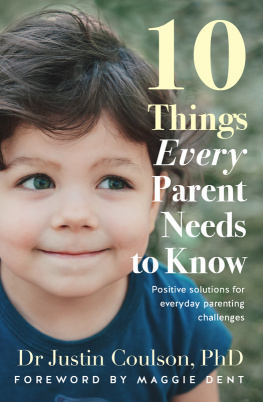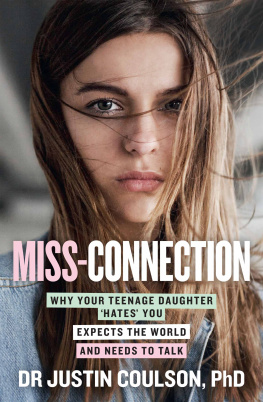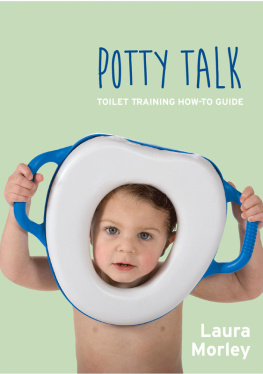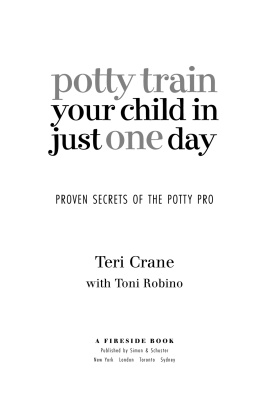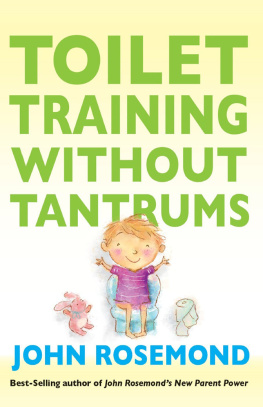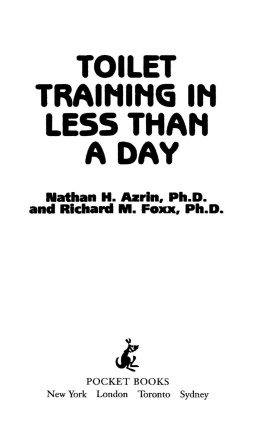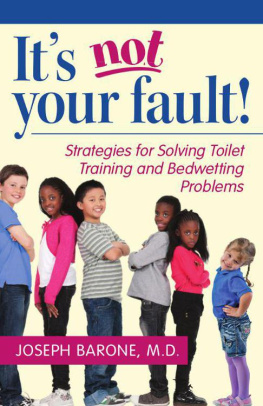Introduction
Toilet-training is a milestone that most parents long for and look forward to with enthusiasm. For parents it means no more mess! If everything goes well, our hands may never have to touch poo again! The smell of urine wafting from the laundry all but disappears. Deciding whether the undies should be scrubbed clean or thrown away becomes a thing of the past!
Frantic dashes for privacy, constantly asking, Do you need to go to the potty?, and regularly finding unexpected surprises on the floor (usually by treading in a puddle while wearing socks) these are the things that are consigned to history once successful toilet-training is achieved. And doesnt it sound exciting?
Who Is This E-Book For?
This e-book has been written specifically for busy parents who want simple, clear, direct answers without having to wade through pages and pages of theories designed to drive parents mad in the hope that their child will go potty.
This e-book is not for parents of children who are well past the average age for toilet-training, and who are still experiencing toileting difficulties. Similarly, the book does not deal with specific issues that children with disabilities, or who are on the autism spectrum, may experience with toilet-training. While there may be information in here that is helpful, the book is not written as the answer to everything toilet-related.
If you have a child who is older than five years and who is not toilet-trained, or if you have a child with cognitive or other delays or challenges, seek specific, individual, professional help.
Contents
CHAPTER 1
Toilet-Training by the Numbers
The age at which toilet-training occurs has shifted in recent decades. In 1957, researchers identified that by 18 months of age, 92% of children were toilet-trained. Just over 40 years later, in 1999, that number had reduced to only 25%.
Were 1950s parents lying? Did they tell the researchers that their children were toilet-trained so that they would look like good parents? Or were they doing something entirely differently to what we do today?
The same data showed that in 1999, only 60% of kids were fully toilet-trained at 36 months (i.e., 3 years!), and 2% of children were still completely un-trained at age 4.
Because this e-book is written from an Australian perspective, the following data comes from what may be the only study into toilet-training using Australian participants. The study is based on a relatively small sample of just over 50 Aussie families, and provides the following facts (which are broadly in line with data from other Western nations including the USA, UK, and Europe):
Average age toilet-training achieved: 28.7 months (or 2 years, 3 months).
Average age for boys: 30.2 months
Average age for girls: 27.5 months
Night Time Toilet-Training
Night time toilet-training is not a focus of this book. The emphasis in this book is on day-time continence and regulation. But there are a few things worth noting about Nocturnal enuresis (or night time bed wetting).
In the Australian research I pointed to above, over 40% of the children were still experiencing wet beds. The age range included in the study was 2-6 years, so presumably this was younger children as a rule. Also, note that 2-6 years is a very broad range, so Im not convinced that this specific number is useful. The following may be, however. For the 59% of children who were able to hold their urine through the night, they had developed the capacity to hang on from 31.7 months, or nearly 2 years and 8 months.
As with the daytime toilet training, and in line with general findings from around the world, girls were far more likely to be toilet-trained at night: 61%
But When Is My Child Actually Ready?
Current evidence indicates that children have no bladder or bowel control until the age of 12 months, and only slight control for 6 months after that. That is not to say they dont have awareness. There is evidence that they do. Rather, they cannot control what their bladder does.
As well discover in more detail later in this e-book, the general consensus among mainstream researchers and medical practitioners is that toilet training should occur when the child demonstrates a desire to control bladder and bowel emptying usually starting somewhere around 18 months.
There are a handful of tell-tale signs that your child may be ready to toilet-train. The signs of readiness include:
- Asking to use the potty/toilet
- Asking to wear underwear rather than nappies
- Being able to take clothes off AND put them back on again (we all know kids love taking their clothes off , but arent capable of putting them on again with any degree of proficiency.)
- Following parents into the bathroom and is showing interest in how parents go to the toilet
- Showing some control over bowel or bladder elimination
- Being able to follow basic instructions
- Complaining when nappies are unclean
- Having a dry nappy for a couple of hours at a time (although this will vary from child to child)
- Being dry after naps
- Makes it clear (via words or facial expressions) that she needs to use the toilet.
Some researchers dispute these signs as being valid indicators of readiness, arguing that they intentionally prolong the time that a child will be in nappies. Some people point out that much research into toilet-training is sponsored by nappy companies! Nevertheless, there is a general level of acceptance among scholars and other experts that these milestones are probably reasonable markers of readiness.
This research is cited in Feldman, R. S (2011). Lifespan development. New Jersey: Prentice Hall. It originally comes from Brazelton, T. B. (1962). A child-oriented approach to toilet training. Pediatrics , . There are further studies that confirm these data for those who would like to learn more:
Blum, N. J., Taubman, B., & Nemeth, N. (2004). Why is toilet training occurring at older ages? A
study of factors associated with later training. The Journal of Pediatrics , 107-111.
Schum, T. R., Kolb, T. M., McAuliffe, T. L., Simms, M. D., Underhill, R. L., & Lewis, M. (2002). Sequential acquisition of toilet-training skills: A descriptive study of gender and age differences in normal children. Pediatrics, , p48.
Taubman, B. (1997). Toilet training and toileting refusal for stool only: A prospective study. Pediatrics , , 54-580.
Christie, A. (2010). Toilet training of infants and children in Australia: 2010 parental attitudes and practices. Retrieved from http://web.maths.unsw.edu.au/~jim/annachristierpt10.pdf on May 14th, 2014.
Stadtler, A. C., Gorski, P. A., & Brazelton, T. B. (1999). Toilet training methods, clinical interventions, and recommendations. Pediatrics , , 1359-1361. See also Feldman, R. S (2011). Lifespan development . New Jersey: Prentice Hall.
See Blum, N. J., Taubman, B., & Nemeth, N. (2003). Relationship between age at initiation of toilet-training and duration of training: A prospective study. Pediatrics , , 810-814.
CHAPTER 2
Toilet-Training Myths
There are so many different ideas about toilet-training that it can be hard to determine myth from reality. Lets take a look at a handful of myths that can cause frustration for parents trying to work out how to toilet-train their children.
Myth 1: Put your baby on the potty early and hell learn how it works
Some parents believe that if they place their child on the potty, the child will figure it out. Or if they run and put them on the potty whenever they start to pee or poo, that their child will form an association with those bodily functions and potty use. Perhaps some kind of association may form, but generally, our children need to understand their urges and have a desire to eliminate somewhere other than their pants before these strategies will work. In addition to that understanding and desire, children need explicit training, support, choice, and a sense of autonomy and competence to toilet-train.
Next page

